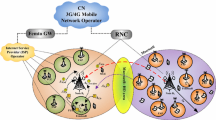Abstract
In future mobile telecommunications, due to the huge number of users and the specific functions that support mobility, a significant amount of signaling load will have to be carried by the finite capacity of the radio link. Hence, methods aiming at radio link signaling load reduction are welcome. In this paper we propose and analyze a method that saves paging signaling load by exploiting information related to the terminal location during the most recent interaction between the terminal and the network. The penalty paid is extra processing power and extra paging delays. An analytical model is developed so as to describe the performance versus traffic intensity and mobility conditions. The performance of the proposed paging scheme is investigated, and it is shown that the method operates well even in the worst case, which is the high user mobility conditions. Possible extensions of the method, which exploit information related to the mobility degree of each individual user or information characterizing the mobility conditions in a certain location area, are also proposed.
Similar content being viewed by others
References
Michel Mouly and Marie-Bernadette Pautet,The GSM System for Mobile Communications, published by the authors, 1992.
Behrokh Samadi and Wing S. Wong, Optimisation techniques for location area partitioning,8th ITC Specialist Seminar on Universal Personal Telecommunication, Geneva, October 1992.
Sadaatsu Okasaka, Seizo Onoc, Syuji Yasoda, and Akiro Maebara, A new location updating method for digital cellular systems, 41st VTS Conference, St. Louis, Missouri, 1991.
J. G. Markoulidakis, G. L. Lyberopoulos, D. F. Tsirkas, and E. D. Sykas, Evaluation of location area planning scenarios in future mobile telecommunication systems,Wireless Networks Journal, Vol. 1, No. 1, pp. 17–29, 1995.
Amotz Bar-Noy and Ilan Kessler, Tracking mobile users in wireless communications networks,Proc. INFOCOM '93, pp. 1232–1239, 1993.
G. L. Lyberopoulos, J. G. Markoulidakis, D. V. Polymeros, D. F. Tsirkas, and E. D. Sykas, Intelligent paging strategies for third generation mobile telecommunication systems,IEEE Transactions on Vehicular Technology Vol. 44, No. 3, Aug. 1995.
RACE 2066 Mobile Networks (MoNet) project, CEC Deliverable No R2066/BT/PM2/PS/070/b2, UMTS System Structure Document, Issue 2.0, Dec. 1994.
CEC Deliverable No. 43/RNL/FN12/DS/A/067/bl,Fixed Network Activities 1991, RMTP/FN, Issue 1.0, 5/12/1991.
J. G. Markoulidakis and E. D. Sykas, Model for location updating and handover rate estimation in mobile telecommunications,IEE Electronics Letters, Vol. 29, No. 17, pp. 1574–1575, 1993.
Author information
Authors and Affiliations
Additional information
This paper has been partially funded by CEC through the RACE 2066 Mobile Network (MONET) project. The paper does not present the views of the project as a whole, but those of the authors.
Rights and permissions
About this article
Cite this article
Markoulidakis, J.G., Sykas, E.D. Performance bounds of a multiple-step paging strategy in future universal mobile telecommunication systems. Int J Wireless Inf Networks 2, 133–147 (1995). https://doi.org/10.1007/BF01577278
Issue Date:
DOI: https://doi.org/10.1007/BF01577278




